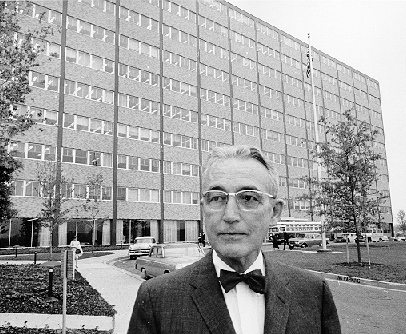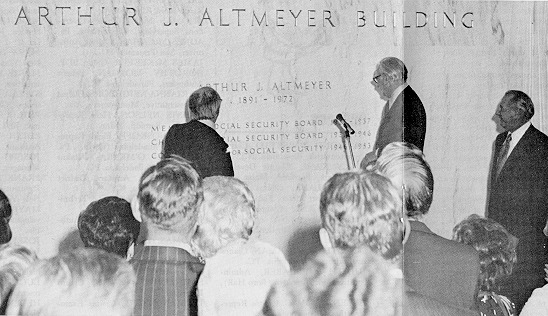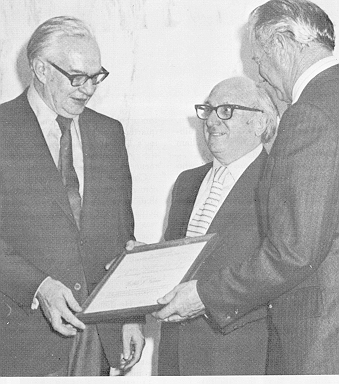Arthur J. Altmeyer
A Building is Dedicated
SSA's headquarters in suburban Baltimore, Maryland was occupied in 1960. The main building, a ten-story structure, was named the Administration Building at that time, as it housed the offices of the top officials of the agency. When Arthur Altmeyer died in October 1972, it was decided to re-name the Administration Building the Altmeyer Building in his honor. The dedication ceremony took place on January 19, 1973. This is an article from the March 1973 issue of OASIS reporting on the dedication ceremonies.
Altmeyer in front of the SSA headquarters in Baltimore--May 1963.
Less than 10 years after this picture was taken the building was renamed in his honor.

Former HEW Secretary Wilbur Cohen, Commissioner Ball, outgoing Under Secretary John Veneman,
and others on hand for the dedication view the inscription on the Altmeyer Building's marble walls. OASIS
FRANK BANE, Wilbur Cohen, Oscar Pogge, Maurine Mulliner, Robert Myers, William Mitchell, J. Douglas Brown.... These and many more people who played an important role in the history of Social Security were at headquarters on January 19. They were present to pay tribute to one of their former friends and associates--the late Arthur J. Altmeyer. The occasion was the rededication of the Administration Building to the memory of Mr. Altmeyer.
Arthur Altmeyer, who died last year on October 16, is known as the father of social security. He had served as chairman of the Technical Board that drafted the original social security legislation in 1934, was a member and then chairman of the Social Security Board, and was the first Commissioner for Social Security.
The 10-story building dedicated in his honor stands in the center of Social Security's Woodlawn complex. Opened in 1960, its occupants include the commissioner, deputy commissioner, and members of SSA's top staff. It's the place where most visitors are welcomed and tours of headquarters start. A section of the building's 1,000-seat auditorium is where the dedication ceremonies commenced.
Commissioner Robert Ball welcomed the guests and then stated that before getting down to the actual dedication, another ceremony was going to take place. "This first ceremony is really a very important one," he said, "and it appropriately also involves Arthur Altmeyer. It is the presentation of the Arthur J. Altmeyer Award for Outstanding Contributions to Economic Security." He then introduced HEW Under Secretary John Veneman who made the award presentation to Wilbur Cohen, former HEW Secretary.
Mr. Veneman told the audience that he really had a two-fold purpose for his SSA visit. "First of all," he said, "I'm going to take this opportunity to express my personal and deepest appreciation to everybody in this room and everybody in this building and everybody in the Social Security Administration . . . for the cooperation and the courtesies and the education that I've received during the past 4 years. As I look back on that chapter in my life I can only say it has probably been one of the most exciting experiences a man can have...." (Under Secretary Veneman returned to private life in January. )
In presenting the Altmeyer Award, Mr. Veneman commented: "It has been pointed out quite frequently, and, I think very rightfully and appropriately, that Arthur Altmeyer was known as the father of social security. But I feel it my duty to point out also that the man we are about to honor . . . was also very much present in the very beginning and has also been called the father of social security. Now, I'm not going to get involved in a paternity discussion here, but I'm sure we will all recognize that ever since the very beginning, that moment in history when social security was started, the person we are honoring here today has moved steadily upward in the Service of his country and his countrymen . . . Theodore White once wrote of him: 'After all his years in the Capital, he has lost none of his humanitarian glow and he feels that every person in the country who is home, sick and alone, is his personal responsibility....' "
Only two other people have received the Altmeyer Award--Robert Ball and J. Douglas Brown, Provost and Dean Emeritus of the Faculty of Princeton University, who also helped develop the original social security program. Wilbur Cohen's citation reads: "His deep commitment to the cause of human welfare and his unmatched skill in getting ideas transformed into law have opened the way to economic security for scores of millions of Americans down through the ages."
|
| During the dedication ceremonies, former HEW Secretary Wilbur Cohen (c.) received the Altmeyer Award. With him are Commissioner Ball and outgoing Under Secretary John Veneman. OASIS |
Commissioner Ball was next on the informal program, saying: "I wouldn't feel at all right personally if I didn't take the opportunity to say a few things about Arthur Altmeyer myself--partly because he was such an important and pervasive influence on my own life, but of course, so much more importantly, because of his influence on the development of the social security program. It's no exaggeration to say that because he lived, the quality of life in America is much higher than it would otherwise be....
"It has always seemed to me that the contribution Arthur Altmeyer made to the development of the social security program was very specific and personal. He did more, much more, than oversee the building up of an efficient organization. He imprinted on the evolving program and on the administration and in the people who were with it a set of values that are still operative and that have been largely responsible for the success and widespread acceptance and support that the social security system enjoys. . ."
Concluding, Mr. Ball said: "Arthur Altmeyer's influence lives and will continue to live in our hearts and in the great institution which he did so much to shape.... It is fitting and useful . . . to have this building as a continuing reminder of the values and courage and skill of this great and good man. The inspiration that he will be to those who come after, as they look at the inscription when they come into this building, will help build a greater social security and more effective welfare program in this country and in the world...."
Mr. Ball then told the audience that Wilbur Cohen had worked side by side with Arthur Altmeyer throughout his social security career. "He knew more about the inner workings of Arthur Altmeyer's mind and his goals than any other human being," stated the Commissioner as he presented Mr. Cohen to the audience.
The former HEW Secretary's dedicatory remarks traced the first Commissioner for Social Security's career: "Arthur Altmeyer was a great and a towering figure in the social movement in this country. As a dedicated humanist ever concerned about human rights, he saw, in his own words, 'social security as a goal, never a finished thing, because human aspirations are infinitely expandable just as human nature is infinitely perfectable.' He influenced the lives of millions of people as an administrator-innovator, as a teacher, as an educator, and as an economist...."
Mr. Cohen pointed out that Arthur Altmeyer was reared in Wisconsin during the progressive era of the LaFollettes when the Populist movement was in full bloom. "He like others of us who came from Wisconsin . . . believed in public service as an honorable and significant profession. To him a public office was indeed a public trust.
"Currently we hear complaints about legislation and institutions which have not produced results they promise and about the 'establishment' which does not respond to the needs of people. These complaints do not apply to the great institution of social security that Arthur Altmeyer helped to build. The number of persons presently below the poverty line would be increased by 50 percent if the social security program did not exist.... Social security has improved and changed over the past 37 years, but its incremental growth and increasing contribution to the alleviation of both present poverty and the prevention of dependency are tributes to the long-range vision of Arthur Altmeyer....
"Mr. Altmeyer was able to work with Presidents and other political leaders in a very close relationship. But, as I think of him, he always thought of the individual and the family as the central element in social policy....
"I think he believed . . . that the way an institution gets started has a great deal to do with how an institution works over the long run.... I recall one day opening the little door between my office and Mr. Winant's office, when Mr. Winant was Chairman of the Board [Social Security Board, forerunner of the Social Security Administration].... I found Mr. Winant and Mr. Altmeyer down on the floor, on their knees, with 3 x 5 cards containing all the names of all the people they were thinking about for appointment as the first field office managers of this great program.... Bit by bit, they knew every person. They knew their background. They chose every one of those people to start the program, because as far as they were concerned they knew that the essence of getting this program started well was selecting men and women of integrity and ability. And at no time did they allow political factors to intervene in their choice...."
Concluding, Mr. Cohen said he hopes that principle will always remain inviolate, "that the men and women who administer this program be selected on the basis of competence, on the basis of vision, and their promotions and their development to positions of leadership be based on the highest ideals that Arthur J. Altmeyer set for this program when it was first developed.
"So, as we dedicate this building in his name, I hope that the building will always be an ever-present testimonial to the contributions of this great and good man. His ideals and his accomplishments will always remain a beacon light in what I think is the continued expansion and development of a social security program that will be in the interest of all of the American people."
The audience then went into the lobby for the unveiling of the inscription. Wilbur Cohen, John Veneman, and Robert Ball pulled back the drapery to reveal the gold-leaf lettering on the white marble wall reading, ARTHUR J. ALTMEYER BUILDING. As one of the visitors summed up the festivities: "Not only was this day a great tribute to Arthur, but it gave us a chance to visit with the friends we made back in the early days of social security."
Some faces in the crowd. . . . |
|
| Attending the dedication ceremony were many of Arthur Altmeyer's friends and associates from the early days of Social Security. Among those present who left their mark on the program were (from l.): Maurine Mulliner, who was the first Secretary of the Social Security Board (1936-44) and, later, Executive Assistant and Staff Advisor for Planning (1947-62); Frank Bane, who was the Board's Executive Director from 1935 to 1938; Oscar Pogge, who served as Director of the Bureau of Old-Age and Survivors Insurance during most of the 1940's and through May 1953; and William Mitchell, a former Commissioner of Social Security whose service goes back to 1936 when he became Director of the Bureau of Business Management--a part of the original Social Security Board. |
OASIS 1973

